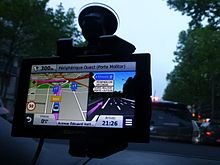History of radio § Broadcasting
Radio location
Radio locating is the process of finding the location of something
through the use of radio waves. It generally refers to passive uses,
particularly radar—as well as detecting buried cables, water mains and
other public utilities. It is similar to radio navigation, but
radiolocation usually refers to passively finding a distant object rather than
actively one's own position. Both are types of radio determination. Radiolocation
is also used in real-time locating system (RTLS) for tracking
valuable assets.
Basic Principal
An object can be located by measuring the
characteristics of received radio waves. The radio waves may be transmitted by
the object to be located, or they may be backs cattered waves (as
in radar or passive RFID). A stud finder uses
radiolocation when it uses radio waves rather than ultrasound.
One technique measures a distance by using the difference in the
power of the received signal strength (RSSI) as compared to the originating
signal strength. Another technique uses the time of arrival (TOA), when the
time of transmission and speed of propagation are known. Combining TOA data
from several receivers at different known locations (time difference of
arrival, TDOA) can provide an estimate of position even in the absence of
knowledge of the time of transmission. The angle of arrival (AOA) at a
receiving station can be determined by the use of a directional Dinformation may be combined with distance
estimates from the techniques previously described to establish the location of
a transmitter or backs catterer. Alternatively, the AOA at two receiving
stations of known location establishes the position of the transmitter. The use
of multiple receivers to locate a transmitter is known as multilateration.
Estimates
are improved when the transmission characteristics of the medium is factored
into the calculations. For RSSI this means electromagnetic permeability for
TOA it may mean non-line-of- sight receptions.




Comments
Post a Comment